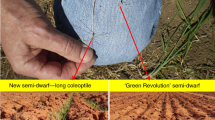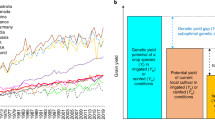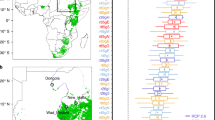Abstract
Price surges in staple foods trigger civil unrest and conflict1. The food riots of 2007–2008 and Arab spring uprisings (2010–2012) were, in part, a consequence of price increases due to a tightening supply of staple grains, particularly wheat. Prolonged drought in Australia contributed to the global wheat shortage; Australia accounts for 10% of global wheat exports2. Australian wheat yields have plateaued3 owing to reduced rainfall4,5 and increasing temperatures3 attributed to anthropogenic climate change6. If Australia is to increase wheat production in line with projected global population growth and demand, an increase in yield is required7. Crop simulations reveal that an early sowing system combined with slower-developing wheat genotypes could exploit a longer growing season8. We developed near-isogenic lines and tested this hypothesis in experiments across the grain belt of Australia, and extended the results using whole-farm simulations. Our proposed early sowing system can increase national yields by 0.54 (s.d. = 0.38) t ha−1 representing an additional 7.1 Mt annually under reduced rainfall and increasing temperature regimes. This adaptation could facilitate increasing yields across Australia under climate change with global food security benefits.
This is a preview of subscription content, access via your institution
Access options
Access Nature and 54 other Nature Portfolio journals
Get Nature+, our best-value online-access subscription
$29.99 / 30 days
cancel any time
Subscribe to this journal
Receive 12 print issues and online access
$209.00 per year
only $17.42 per issue
Buy this article
- Purchase on Springer Link
- Instant access to full article PDF
Prices may be subject to local taxes which are calculated during checkout



Similar content being viewed by others
Data availability
The data that support the findings of this study are available from the corresponding author upon request.
References
FAO, IFAD, UNICEF, WFP & WHO. The State of Food Security and Nutrition in the World 2017. Building Resilience for Peace and Food Security (FAO, 2017).
Fischer, R. A., Byerlee, D. & Edmeades, G. O. Crop Yields and Global Food Security: Will Yield Increase Continue to Feed the World? ACIAR Monograph No. 158 (Australian Centre for International Agricultural Research, 2014).
Hochman, Z., Gobbett, D. L. & Horan, H. Climate trends account for stalled wheat yields in Australia since 1990. Glob. Change Biol. 23, 2071–2081 (2017).
Pook, M. et al. The autumn break for cropping in southeast Australia: trends, synoptic influences and impacts on wheat yield. Int. J. Climatol. 29, 2012–2026 (2009).
Cai, W., Cowan, T. & Thatcher, M. Rainfall reductions over Southern Hemisphere semi-arid regions: the role of subtropical dry zone expansion. Sci. Rep. 2, 702 (2012).
Cai, W. J. & Cowan, T. Southeast Australia autumn rainfall reduction: a climate-change-induced poleward shift of ocean–atmosphere circulation. J. Clim. 26, 189–205 (2013).
Qureshi, M. E., Hanjra, M. A. & Ward, J. Impact of water scarcity in Australia on global food security in an era of climate change. Food Policy 38, 136–145 (2013).
van Rees, H. et al. Leading farmers in South East Australia have closed the exploitable wheat yield gap: prospects for further improvement. Field Crops Res. 164, 1–11 (2014).
Flohr, B. M., Hunt, J. R., Kirkegaard, J. A. & Evans, J. R. Water and temperature stress define the optimal flowering period for wheat in south-eastern Australia. Field Crops Res. 209, 108–119 (2017).
Kerr, N. J., Siddique, K. H. M. & Delane, R. J. Early sowing with wheat cultivars of suitable maturity increases grain-yield of spring wheat in a short season environment. Aust. J. Exp. Agric. 32, 717–723 (1992).
Bodner, G., Nakhforoosh, A. & Kaul, H. P. Management of crop water under drought: a review. Agron. Sustain. Dev. 35, 401–442 (2015).
Kirkegaard, J. A. et al. Effect of defoliation by grazing or shoot removal on the root growth of field-grown wheat (Triticum aestivum L.). Crop Pasture Sci. 66, 249–259 (2015).
Passioura, J. B. & Angus, J. Improving productivity of crops in water-limited environments. Adv. Agron. 106, 37–75 (2010).
Kemanian, A. R., Stockle, C. O. & Huggins, D. R. Transpiration-use efficiency of barley. Agric. For. Meteorol. 130, 1–11 (2005).
Fletcher, A., Lawes, R. & Weeks, C. Crop area increases drive earlier and dry sowing in Western Australia: implications for farming systems. Crop Pasture Sci. 67, 1268–1280 (2016).
Flohr, B. M. et al. Fast winter wheat phenology can stabilise flowering date and maximise grain yield in semi-arid Mediterranean and temperate environments. Field Crops Res. 223, 12–25 (2018).
Zheng, B., Chapman, S. C., Christopher, J. T., Frederiks, T. M. & Chenu, K. Frost trends and their estimated impact on yield in the Australian wheatbelt. J. Exp. Bot. 66, 3611–3623 (2015).
Penrose, L. D. J. & Martin, R. H. Comparison of winter habit and photoperiod sensitivity in delaying development in early-sown wheat at a site in New South Wales. Aust. J. Exp. Agric. 37, 181–190 (1997).
Shavrukov, Y. et al. Early flowering as a drought escape mechanism in plants: how can it aid wheat production? Front. Plant Sci. 8, 1950 (2017).
Eagles, H. A., Cane, K. & Vallance, N. The flow of alleles of important photoperiod and vernalisation genes through Australian wheat. Crop Pasture Sci. 60, 646–657 (2009).
Hunt, J. R. Winter wheat cultivars in Australian farming systems: a review. Crop Pasture Sci. 68, 501–515 (2017).
Hochman, Z. et al. Quantifying yield gaps in rainfed cropping systems: a case study of wheat in Australia. Field Crops Res. 136, 85–96 (2012) .
Penrose, L. Yield of early dryland sowing of wheat with winter and spring habit in southern and central New South Wales. Aust. J. Exp. Agric. 33, 601–608 (1993).
Coventry, D. R., Reeves, T. G., Brooke, H. D. & Cann, D. K. Influence of genotype, sowing date, and seeding rate on wheat development and yield. Aust. J. Exp. Agric. 33, 751–757 (1993).
Gomez-Macpherson, H. & Richards, R. A. Effect of sowing time on yield and agronomic characteristics of wheat in south-eastern Australia. Aust. J. Agric. Res. 46, 1381–1399 (1995).
Woodruff, D. R. & Tonks, J. Relationship between time of anthesis and grain-yield of wheat genotypes with differing developmental patterns. Aust. J. Agric. Res. 34, 1–11 (1983).
Holzworth, D. P. et al. APSIM — evolution towards a new generation of agricultural systems simulation. Environ. Model. Softw. 62, 327–350 (2014).
Fletcher, A. L., Robertson, M. J., Abrecht, D. G., Sharma, D. L. & Holzworth, D. P. Dry sowing increases farm level wheat yields but not production risks in a Mediterranean environment. Agric. Syst. 136, 114–124 (2015).
Agricultural Commodity Statistics 2017 (Australian Bureau of Agricultural and Resource Economics and Sciences, 2017).
Hochman, Z. & Horan, H. Causes of wheat yield gaps and opportunities to advance the water-limited yield frontier in Australia. Field Crops Res. 228, 20–30 (2018).
Steinfort, U., Trevaskis, B., Fukai, S., Bell, K. L. & Dreccer, M. F. Vernalisation and photoperiod sensitivity in wheat: impact on canopy development and yield components. Field Crops Res. 201, 108–121 (2017).
Cane, K. et al. Ppd-B1 and Ppd-D1 and their effects in southern Australian wheat. Crop Pasture Sci. 64, 100–114 (2013).
Bell, L. W., Lilley, J. M., Hunt, J. R. & Kirkegaard, J. A. Optimising grain yield and grazing potential of crops across Australia’s high-rainfall zone: a simulation analysis. 1. Wheat. Crop Pasture Sci. 66, 332–348 (2015).
Flohr, B. M., Hunt, J. R., Kirkegaard, J. A., Evans, J. R. & Lilley, J. M. Genotype × management strategies to stabilise the flowering time of wheat in the south-eastern Australian wheatbelt. Crop Pasture Sci. 69, 547–560 (2018).
Asseng, S. et al. Performance of the APSIM-wheat model in Western Australia. Field Crops Res. 57, 163–179 (1998).
Carberry, P. S. et al. Re-inventing model-based decision support with Australian dryland farmers. 3. Relevance of APSIM to commercial crops. Crop Pasture Sci. 60, 1044–1056 (2009).
Land Use of Australia. v.4 2005–06 http://www.agriculture.gov.au/abares/aclump/land-use/data-download (ABARE-BRS, 2010).
Acknowledgements
This research is funded by GRDC co-investment in projects CSP00178 ‘Increasing yield and reducing risk through early sowing in the southern grains region’ and CSP00183 ‘Pedigree based association genetics of wheat phenology’. We thank Living Farm, Eurofins, AgGrow Agronomy, SARDI, QDAF, FAR Australia, Southern Farming Systems, B. Rheinheimer, A. Swan, L. Goward, J. Byrne, A. Wixon and J. Lawrence for managing regional experiments. We thank all wheat growers who hosted field experiments.
Author information
Authors and Affiliations
Contributions
B.T. developed the near isogenic lines. J.R.H., A.B.Z., A.F., A.P., B.T. and B.M.F. conceptualized and designed the experiments. J.R.H. analysed the experimental data. J.R.H., A.F., A.P. and B.M.F. maintained field experiments and collected field data. J.M.L. and J.R.H. designed the APSIM whole-farm simulation, J.M.L. conducted the simulation, and analysed and prepared figures. D.G. prepared maps and spatially extrapolated simulation results. J.R.H., J.M.L. and J.A.K. wrote the manuscript, with edits and contributions from all other authors.
Corresponding author
Ethics declarations
Competing interests
The authors declare no competing interests.
Additional information
Journal peer review information: Nature Climate Change thanks Sheri Strydhorst, Miroslav Trnka, Ken Giller and the other anonymous reviewer(s) for their contribution to the peer review of this work.
Publisher’s note: Springer Nature remains neutral with regard to jurisdictional claims in published maps and institutional affiliations.
Supplementary information
Supplementary Information
Supplementary Figure 1, Supplementary Tables 1–5
Rights and permissions
About this article
Cite this article
Hunt, J.R., Lilley, J.M., Trevaskis, B. et al. Early sowing systems can boost Australian wheat yields despite recent climate change. Nat. Clim. Chang. 9, 244–247 (2019). https://doi.org/10.1038/s41558-019-0417-9
Received:
Accepted:
Published:
Issue Date:
DOI: https://doi.org/10.1038/s41558-019-0417-9
This article is cited by
-
Temporary growth cessation of wheat roots following defoliation
Plant and Soil (2024)
-
Diversity of gene expression responses to light quality in barley
Scientific Reports (2023)
-
Natural variation and genetic loci underlying resistance to grain shattering in standing crop of modern wheat
Molecular Genetics and Genomics (2023)
-
Yield maximization in wheat through nutrient management and plant growth regulators
Environment, Development and Sustainability (2023)
-
Silver lining to a climate crisis in multiple prospects for alleviating crop waterlogging under future climates
Nature Communications (2023)



